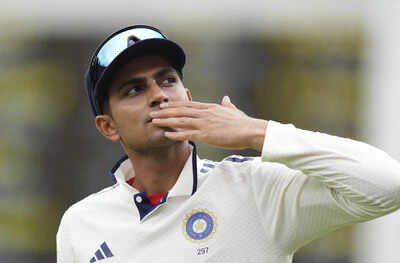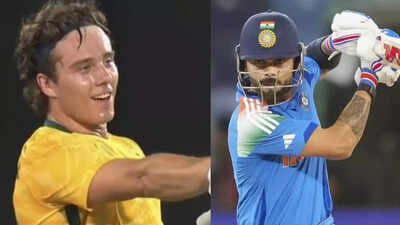Is it time for India to back Shubman Gill as all-format captain? | Cricket News

India are in a happy dilemma. Across all three formats, they are atop the ICC charts, and there is a sense of stability around the Indian cricket landscape after a tumultuous four-month phase from Oct last year to Jan 2025. With Shubman Gill shaping up as the new face of Indian cricket, discussions have arisen about appointing the 25-year-old as the all-format captain. India swept every match in T20 cricket this year, leaving little reason to question Suryakumar Yadav’s position in the format. The team won the Champions Trophy, the last ODI tournament they played, under Rohit Sharma’s captaincy. Sharma retired from Tests but remains in charge of ODIs. However, the Mumbai man will be 40 when India compete in the ODI World Cup in South Africa in Oct-Nov 2027, and few in Indian cricket believe he will continue as a player that long. Consequently, there is a strong chance that Gill, a brilliant ODI player himself, will be promoted to the 50-over skipper sooner rather than later. This raises the question: what happens in T20 cricket? ‘SKY’, who is recovering from a sports hernia operation, is striving to be fit for the Asia Cup from Sept 9. Axar Patel is his current deputy, but it is unlikely the all-rounder will be viewed as a long-term captaincy option by India. In such a scenario, there is talk of making Gill the T20 vice-captain, grooming him to take over as an all-format captain after the T20 World Cup in India in Feb-March 2026. Historically, the one-captain theory has worked for India. MS Dhoni won the T20 World Cup in 2007 while serving as the red-ball vice-captain and was poised to become the all-format leader. In 2011, he captained all formats when the team won the 50-over World Cup, and a similar situation applied when the 2013 Champions Trophy was won in England. By the 2024 T20 World Cup, India became world champions again with Rohit Sharma as the all-format captain. Between 2015 and 2017, India had two captains, with Dhoni leading in white-ball cricket and Virat Kohli leading in Tests. Devang Gandhi, the national selector when Kohli became the white-ball captain in early 2017, told TOI that the “transition was smooth.” “At that stage, Kohli was well entrenched as Test captain and playing superbly in white-ball cricket. Dhoni, too, wanted to play the last few years of international cricket without baggage, and the captaincy transition went very well. From a cricket perspective, I feel the Gill situation is pretty much the same,” Gandhi said.
Poll
Should Shubman Gill be appointed as the all-format captain of India?
Gill is a brand-man’s delight. Like Dhoni’s ‘captain cool’ image commanded massive brand value in the 2008-15 era, the swagger of ‘King Kohli’ brought a fresh perspective to the financial aspects of the sport. Rohit, the ‘bindaas boss’ in three formats, was equally appealing while performing well. Now, everything suggests that Gill as the ‘face of new India’ will work like magic. These factors are relevant when the player performs effectively, and that is where Gill shines. His ODI average is an impressive 59.04 with a strike rate of 99.56, and in T20Is, he averages a respectable 30.47 with a strike rate of 139.27. It is noteworthy that he was India’s T20 captain in Zimbabwe last year right after the T20 World Cup and performed well in Sri Lanka thereafter. “Don’t forget that he was not dropped when India was playing T20 cricket in South Africa towards the end of the year, a series India won 3-1. He was rested after the New Zealand series in India as the team was about to embark on the tour of Australia, and after his immense success in the IPL as a player and captain, everything suggests he should be vice-captain in the Asia Cup,” Gandhi said. Is workload management an issue? Recently, India’s three biggest rivals have had multiple captains. Australia have been led by Pat Cummins in Tests and ODIs, while Mitch Marsh has been appointed T20 captain. England have Ben Stokes as their Test captain, with Harry Brook taking over as white-ball captain from Jos Buttler. South Africa shares the role between Temba Bavuma (Tests and ODIs) and Aiden Markram (T20Is), while New Zealand has Tom Latham and Mitchell Santner as their two captains. An all-format captain must play most games unless two national teams are playing two formats simultaneously. In such cases, workload management becomes a concern, but India’s former strength and conditioning coach Ramji Srinivasan says “it differs from batters to bowlers.” “For Cummins and Stokes, who have considerable bowling workloads, it is understandable that they relinquish captaincy of one format to preserve themselves. And remember, they’re well into their 30s. A batting captain, meanwhile, doesn’t necessarily face that workload pressure. So it works fine for a much-younger Gill. Probably the more important issue is keeping the mind fresh,” Ramji told TOI. For now, the best way forward for Gill is to be Suryakumar’s apprentice in T20Is until Feb-March. After that, there will be enough time to make a final decision, considering all results.







